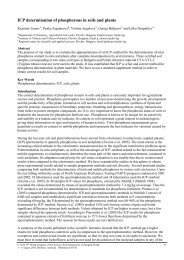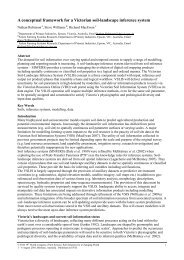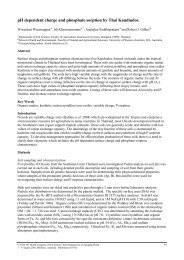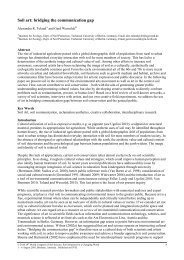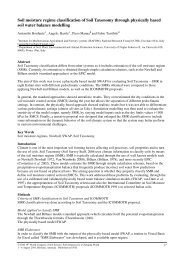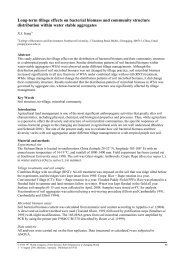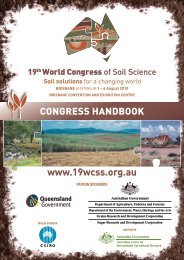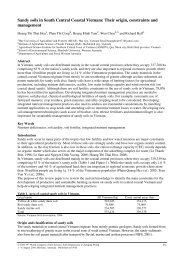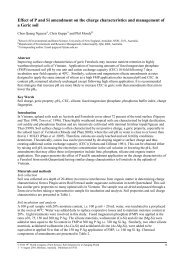Fitzpatrick Rob - International Union of Soil Sciences
Fitzpatrick Rob - International Union of Soil Sciences
Fitzpatrick Rob - International Union of Soil Sciences
Create successful ePaper yourself
Turn your PDF publications into a flip-book with our unique Google optimized e-Paper software.
Chip-tray incubation: A new field and laboratory method to support Acid<br />
Sulfate <strong>Soil</strong> Hazard Assessment, Classification and Communication<br />
<strong>Rob</strong> <strong>Fitzpatrick</strong> A,B Gerard Grealish A,B , Paul Shand A , Richard Merry A , Nathan Creeper A , Mark Thomas A ,<br />
Andrew Baker A , Brett Thomas A,B Warren Hicks A and Nilmini Jayalath A<br />
A CSIRO Land and Water, Urrbrae, South Australia, Australia<br />
B Earth and Environmental <strong>Sciences</strong>, The University <strong>of</strong> Adelaide, South Australia, Australia<br />
Email rob.fitzpatrick@csiro.au; gerard.grealish@csiro.au; paul.shand@csiro.au; richard.merry@csiro.au; nathan.creeper@csiro.au;<br />
Mark.thomas@csiro.au; andrew.k.baker@csiro.au; brett.thomas@csiro.au; warren.hicks@csiro.au, Nilmini.jayalath@csiro.au<br />
Abstract<br />
Chip-trays are plastic containers that are 50.5 cm long by 5.5 cm wide by 3.5 cm deep, and contain 20<br />
compartments - or cells - that can be closed with a snap lock lid. Traditionally used by geologists (e.g. to<br />
store drill core fragments), for the past 5 years we have routinely used chip trays in a range <strong>of</strong> soil<br />
applications including soil survey, forensic investigations and mineralogical studies. This paper, however,<br />
focuses on recent adaptations to acid sulfate soil (ASS) protocols that rely on the use <strong>of</strong> chip-trays, which<br />
<strong>of</strong>fer significant improvements to field sampling and soil storage, and provide the means for a new<br />
laboratory incubation method <strong>of</strong> ASS materials to better characterise and classify ASS types, including<br />
hypersulfidic, hyposulfidic and sulfuric materials. The chip tray-based improvements to ASS protocols have<br />
found use in a wide range <strong>of</strong> projects in diverse Australian ASS landscapes (e.g. coastal, and inland upland,<br />
wetland and riverine environments). For example, characterising hydro-toposequences, constructing ASS<br />
processes models and use in ASS risk assessment protocols.<br />
Key Words<br />
Acid sulfate <strong>Soil</strong>s, incubation, pH, plastic chip-trays, wetlands.<br />
Introduction<br />
The Acid Sulfate <strong>Soil</strong> Working Group <strong>of</strong> the <strong>International</strong> <strong>Union</strong> <strong>of</strong> <strong>Soil</strong> <strong>Sciences</strong> has recently accepted in<br />
principle (see Sullivan et al. 2009b) the following changes to the classification <strong>of</strong> sulfide-containing<br />
materials: (i) revision <strong>of</strong> the concept underlying the existing term <strong>of</strong> “sulfidic” to “soil material containing<br />
detectable inorganic sulfides” and defined as “soil material containing ≥ 0.01% sulfidic S”; (ii) hypersulfidic<br />
material, to describe sulfidic materials that are capable <strong>of</strong> severe acidification (pH < 4) by sulfide oxidation<br />
(this is essentially the same concept underlying the ‘sulfidic’ term as used previously by Isbell 1996 and <strong>Soil</strong><br />
Survey Staff 2003), (iii) hyposulfidic material, to describe sulfidic soil materials that are not capable <strong>of</strong><br />
severe acidification from oxidation (pH > 4 after full oxidation), and (iv) monosulfidic material, to describe<br />
soil materials containing detectable monosulfides. In addition, Sullivan et al. (2009a) recently reviewed and<br />
proposed several improvements to the incubation method that underpins identification <strong>of</strong> ASS materials. The<br />
recommended improved incubation procedure is a modification <strong>of</strong> the duration <strong>of</strong> incubation from the fixed<br />
8-week period in the Australian <strong>Soil</strong> Classification (Isbell 1996) and <strong>Soil</strong> Taxonomy (<strong>Soil</strong> Survey Staff<br />
2003) definitions, to that proposed by Sullivan et al. (2009b), i.e. until a stable pH is reached after at least 8<br />
weeks <strong>of</strong> incubation. Sulfuric material is defined by Isbell (1996) as having a pH < 4, whereas Survey Staff<br />
(2003) has defined a sulfuric horizon as having a pH < 3.5.<br />
The objective <strong>of</strong> this paper is to describe improvements in field sampling, storage and incubation methods to<br />
help better characterise and classify hypersulfidic, hyposulfidic, sulfuric and monosulfidic materials in a<br />
wide range <strong>of</strong> landscapes in Australia. The improvements described include field collection and storage <strong>of</strong><br />
moist soil samples in chip-trays, which <strong>of</strong>fer standardised and improved incubation conditions to those<br />
previously used. This new approach has been extensively tested and refined since 2007 during several ASS<br />
investigations (e.g. <strong>Fitzpatrick</strong> et al. 2008a,b,c; 2009 a,b; Shand et al. 2008 a,b; 2009), and has been adopted<br />
by the Scientific Reference Panel <strong>of</strong> the Murray-Darling Basin (MDB) Acid Sulfate <strong>Soil</strong> Risk Assessment<br />
Group for use in the rapid and detailed assessment <strong>of</strong> acid sulfate soil materials in the MDB (MDBA 2010).<br />
Methods<br />
Use <strong>of</strong> chip trays for sample collection and preparation<br />
Chip-trays (Figure 1) are plastic containers that are 50.5 cm long by 5.5 cm wide by 3.5 cm deep, and<br />
© 2010 19 th World Congress <strong>of</strong> <strong>Soil</strong> Science, <strong>Soil</strong> Solutions for a Changing World<br />
1 – 6 August 2010, Brisbane, Australia. Published on DVD.<br />
28
contain 20 compartments - or cells - that can be closed with a snap lock lid (i.e. partly air-tight). Our adapted<br />
ASS field protocol involves soil layer sub-samples to be placed in two separate plastic chip-trays [i.e.<br />
protocol routinely used by MDBA (2010) and CSIRO Land and Water Acid Sulfate <strong>Soil</strong>s team in Adelaide<br />
see <strong>Fitzpatrick</strong> et al. (2008a,b,c; 2009a,b); Shand et al. (2008 a,b; 2009)]. The first chip-tray is used to<br />
display morphologically representative aggregates for each <strong>of</strong> the sampled layers (compartments filled to ¾<br />
full with representative, intact aggregates or peds) for later-date visual reference (e.g. during report writing),<br />
and subsequently placed in the CSIRO Land and Water Acid Sulfate <strong>Soil</strong> archival system. If present, samples <strong>of</strong><br />
salt efflorescences and/or coatings observed in the field should also be carefully collected and placed in soil<br />
morphology chip-tray for further mineralogical analysis. The second chip-tray (Figure 1) is used for ASS<br />
incubation testing (pH INC ) in the laboratory. Compartments are filled to approximately ⅓ full (Figure 1) by<br />
representative layer samples that are then moistened (not saturated) when necessary with deionised water. After at<br />
least 8-weeks <strong>of</strong> laboratory ageing (or in some cases more than 8 weeks) at approximately 25 °C, the soil<br />
samples are visually checked for formation <strong>of</strong> minerals (e.g. jarosite) that indicate significant acidification.<br />
Since the solution in contact with the soil in the chip-tray compartments is likely to be in equilibrium with<br />
the soil, the ageing pH <strong>of</strong> the whole soil in the tray can be measured using a calibrated pH meter or Merck<br />
pH indicator strips (Merck item numbers: pH 2.5–4.5: 1.09541.0001; pH 4.0–7.0: 1.09541.0002; pH 6.5–<br />
10.0: 1.09543.0001). A pH value <strong>of</strong> 4 or less measured in the chip-tray sample after at least 8-weeks<br />
confirms that the sample, which had a pH > 4 when measured in the field, is likely to develop sulfuric<br />
material on drying (i.e. is hypersulfidic). <strong>Soil</strong> treated with peroxide and then tested for pH is considered the<br />
extreme for oxidising soils and is used as an indicator to characterise ASS when the pH OX [laboratory<br />
equivalent to the field pH after treatment with hydrogen peroxide pH FOX (Ahern et al. 2004)] value is<br />
compared with the pre-treatment pH value. Therefore, we routinely compare the incubated pH values with<br />
pH FOX as a test for identification <strong>of</strong> acid sulfate soils.<br />
Field testing (T 0) 8 weeks (T +8) 10 weeks (T +10)<br />
Figure 1. Time sequence (T 0, T +8, T +10) for a chip-tray <strong>of</strong> soils from the Coorong in South Australia<br />
undergoing incubation. Each photograph shows soil pH as indicated by Merck pH strip colours at: (i) T 0, at<br />
sampling in the field, (ii) at T +8, after incubation for 8 weeks and (iii) at T +10, at 10 weeks. Here pH indicator<br />
strip colours indicate that most samples remain alkaline or neutral (blue colour >pH 7) with only two becoming<br />
acid after incubation for 10 weeks (red or pink colour - pH 3.9 to 4). (<strong>Fitzpatrick</strong> et al. 2008c).<br />
Results and Discussion<br />
The following five case studies describe the versatile use <strong>of</strong> the chip-trays for storing and incubating soil<br />
samples to determine ASS characteristics.<br />
Case study 1 – Lower Lakes (SA) samples showing close relationship between pH INC and pH FOX<br />
Eighty five soils from Lower Lakes and adjacent wetlands in South Australia were assessed by <strong>Fitzpatrick</strong> et<br />
al (2008c) for ASS using pH INC , pH OX and net acid generating potential (NAGP; see Ahern et al. 2004)<br />
measurements. There is good agreement between pH OX and NAGP (see <strong>Fitzpatrick</strong> et al 2008c). The pH INC<br />
(8 weeks) also generally correlates well with pH OX , although pH values were not usually as low as those<br />
measured after peroxide treatment (usually 0.5 to 1.5 units greater). Some incubated samples from the<br />
© 2010 19 th World Congress <strong>of</strong> <strong>Soil</strong> Science, <strong>Soil</strong> Solutions for a Changing World<br />
1 – 6 August 2010, Brisbane, Australia. Published on DVD.<br />
29
Lower Lakes do not proceed to full oxidation within 8 weeks, especially when the soil sample is kept either<br />
too moist or too dry.<br />
Case Study 2 – large data set comparison <strong>of</strong> pH INC with pH OX , and identification <strong>of</strong> acid sulfate soil<br />
materials, River Murray and Lower Lakes, SA<br />
Data from three separate surveys conducted in the lower River Murray and Lower Lakes region were<br />
combined and evaluated (Grealish et al. 2009; <strong>Fitzpatrick</strong> et al. 2009a). This comprised a total <strong>of</strong> 1,452<br />
samples and <strong>of</strong> these, 996 classified as either sulfuric or hypersulfidic. Of the 996 classified samples, 832<br />
classified as hypersulfidic using pH INC (8 weeks). The following results were obtained when comparing<br />
pH INC (8 weeks - for hypersulfidic materials) and pH OX (i.e. pH OX <strong>of</strong>
laboratory ageing in chip-trays, e.g. complex landscape processes, which may include exchange with subsurface<br />
waters (containing Acid Neutralizing Capacity) or biogeochemical reactions. These complex<br />
processes should also be taken into consideration wherever possible with interpretation <strong>of</strong> acid sulfate soil<br />
findings, which will <strong>of</strong>ten require a thorough understanding <strong>of</strong> water movement that is <strong>of</strong>ten site and scenario<br />
specific. The use <strong>of</strong> chip-trays as a valuable tool for characterising ASS has also proved remarkably useful<br />
for community volunteers to collect, discuss, describe and test samples to identify ASS materials.<br />
Acknowledgements<br />
Case studies described in this work have been in part been mostly funded by Murray-Darling Basin<br />
Authority (MDBA), Department <strong>of</strong> Environment and Heritage, South Australia (DEH) and (ii) South<br />
Australian Murray-Darling Basin Natural Resources Management Board (SA MDBNRMB).<br />
References<br />
Ahern CR, McElnea AE, Sullivan LA (2004) ‘Queensland Acid Sulfate <strong>Soil</strong>s Manual 2004’. (Department <strong>of</strong> Natural<br />
Resources, Mines and Energy, Indooroopilly: Queensland, Australia).<br />
Creeper Nathan, <strong>Rob</strong> <strong>Fitzpatrick</strong>, Paul Shand Peter Self, <strong>Rob</strong> Kingham (2010) A systematic analyses procedure<br />
incorporating the chip-tray incubation method for the hazard assessment <strong>of</strong> Acid Sulfate <strong>Soil</strong>s in the Murray Darling<br />
Basin. In ‘World Congress <strong>of</strong> <strong>Soil</strong> Science, <strong>Soil</strong> Solutions for a Changing World 1 – 6 August 2010, Brisbane,<br />
Australia’. (Published on CDROM (Submitted)).<br />
Dent DL (1986) ‘Acid Sulphate <strong>Soil</strong>s: a Baseline for Research and Development. I.RI Pub. No. 39’. (<strong>International</strong><br />
Institute for Land Reclamation and Improvement: Wageningen).<br />
Grealish G, <strong>Fitzpatrick</strong> RW, Chappell A, Marvanek S (2009) ‘<strong>Soil</strong> properties and distribution <strong>of</strong> Acid Sulfate <strong>Soil</strong>s in<br />
the Lower Lakes, South Australia. Prepared for: Department <strong>of</strong> Environment and Heritage, South Australia and<br />
Department <strong>of</strong> Water, Environment, Heritage and Arts. CSIRO Land and Water Science Report 49/09’. (CSIRO:<br />
Adelaide).<br />
<strong>Fitzpatrick</strong> RW, Grealish G, Shand P, Simpson SL, Merry RH, Raven MD (2009a) ‘Acid Sulfate <strong>Soil</strong> Assessment in<br />
Finniss River, Currency Creek, Black Swamp and Goolwa Channel, South Australia. CSIRO Land and Water<br />
Science Report 26/09’. (CSIRO, Adelaide).<br />
<strong>Fitzpatrick</strong> RW, Shand P, Merry RH, (2009b) Acid Sulfate <strong>Soil</strong>s. In ‘Natural History <strong>of</strong> the Riverland and<br />
Murraylands’. (Ed JT Jennings) pp. 65-111 (Royal Society <strong>of</strong> South Australia Inc.: Adelaide, South Australia).<br />
<strong>Fitzpatrick</strong> RW, Shand P, Marvanek S, Merry RH, Thomas M, Simpson SL, Raven MD, McClure S (2008a) ‘Acid<br />
sulfate soils in subaqueous, waterlogged and drained soil environments in Lake Albert, Lake Alexandrina and River<br />
Murray below Blanchetown (Lock 1): properties, distribution, genesis, risks and management. Prepared for Department<br />
<strong>of</strong> Environment and Heritage, SA. CSIRO Land and Water Science Report 46/08’. (CSIRO: Adelaide, 167).<br />
<strong>Fitzpatrick</strong> RW, Shand P, Thomas M, Merry RH, Raven MD, Simpson SL (2008b) ‘Acid sulfate soils in subaqueous,<br />
waterlogged and drained soil environments <strong>of</strong> nine wetlands below Blanchetown (Lock 1), South Australia:<br />
properties, genesis, risks and management. Prepared for South Australian Murray-Darling Basin Natural Resources<br />
Management Board. CSIRO Land and Water Science Report 42/08’. (CSIRO: Adelaide).<br />
<strong>Fitzpatrick</strong> RW, Shand P, Merry RH, Thomas B, Marvanek S, Creeper N, Thomas M, Raven MD, Simpson, SL,<br />
McClure S, Jayalath N (2008c) ‘Acid sulfate soils in the Coorong, Lake Alexandrina and Lake Albert: properties,<br />
distribution, genesis, risks and management <strong>of</strong> subaqueous, waterlogged and drained soil environments. Prepared for<br />
Department <strong>of</strong> Water, Environment, Heritage and Arts. CSIRO Land and Water Science Report 52/08’. (CSIRO:<br />
Adelaide).<br />
Isbell RF (1996) ‘The Australian <strong>Soil</strong> Classification System’. (CSIRO Publishing: Melbourne).<br />
MDBA (Murray–Darling Basin Authority) (2010) ‘Detailed Assessment <strong>of</strong> Acid Sulfate <strong>Soil</strong>s in the Murray-Darling<br />
Basin: Protocols for Sampling, Field Characterisation, Laboratory Analysis and Data Presentation’. (MDBA<br />
Publication 57/10).<br />
Shand P, Merry RH, <strong>Fitzpatrick</strong> RW (2008a) ‘Acid sulfate soil assessment <strong>of</strong> Lock 8 and Lock 9 Weir Pools. CSIRO<br />
Land and Water Science Report 40/08’.<br />
Shand P, Merry RH, <strong>Fitzpatrick</strong> RW (2008b) ‘Acid sulfate soil assessment <strong>of</strong> the Noora Basin, SA. CSIRO Land and<br />
Water Science Report 41/08’.<br />
Shand P, Merry RH, <strong>Fitzpatrick</strong>, RW, Thomas M (2009) ‘Acid sulfate soil assessment <strong>of</strong> disconnected wetlands<br />
between Lock 1 and Lock 5, River Murray, South Australia’. (CSIRO: Water for a Healthy Country National<br />
Research Flagship).<br />
<strong>Soil</strong> Survey Staff (2003) ‘Keys to <strong>Soil</strong> Taxonomy. 9 th Ed’. (USDA–Natural Resources Conservation Service:<br />
Washington, DC).<br />
Sullivan LA, Ward NJ, Bush RT, Burton ED (2009a) Improved identification <strong>of</strong> sulfidic soil materials by a modified<br />
incubation method. Geoderma 149, 33 – 38.<br />
Sullivan LA, <strong>Fitzpatrick</strong> RW, Bush, RT, Burton ED, Shand P, Ward NJ (2009b) ‘Modifications to the Classification <strong>of</strong><br />
Acid Sulfate <strong>Soil</strong> Materials. Southern Cross GeoScience Tech Report 309’.<br />
© 2010 19 th World Congress <strong>of</strong> <strong>Soil</strong> Science, <strong>Soil</strong> Solutions for a Changing World<br />
1 – 6 August 2010, Brisbane, Australia. Published on DVD.<br />
31



